Chicago Students Experience STEM, Illinois During ChiS&E Campus Visit
January 16, 2020
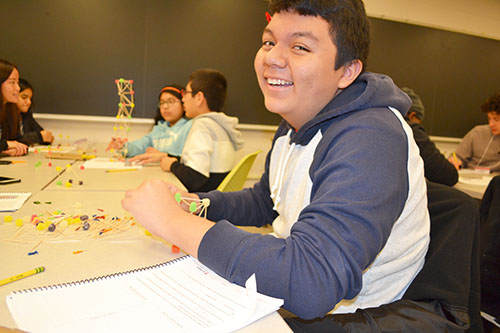
A ChiS&E seventh grader enjoys making his team's toothpick-gumdrop structure.
So excited about STEM that they put their usual Saturday morning activities on hold, a number of Chicago Public School 7th and 8th graders (and even some parents) travelled down to Illinois on December 7, 2019, for a campus visit sponsored by Grainger Engineering’s ChiS&E program. The goal was to further reinforce the youngsters’ journey along the STEM pipeline. Event planners hoped to pique the students’ interest in STEM through a variety of fun, hands-on engineering activities; introduce them both to the campus and to some of its people; and, as the name of the event—“Young Physicists and Computer Scientists”—implies, instill in them the notion that they too can achieve careers in STEM.
Illinois’ ChiS&E program partners with the long-standing Chicago Pre College Science and Engineering Program (also ChiSE), their mutual goal being to introduce Chicago K–12 students to STEM at an early age by exposing them to fun, hands-on engineering activities with the goal of increasing the number of minority students in STEM. The early December campus visit was one of the highlights of the fall ChiS&E program, which had involved Lara Hebert and teams of Illinois engineering undergraduates traveling to UIC (University of Illinois-Chicago) for the three Saturdays prior to the event where they engaged ChiS&E participants in STEM activities.
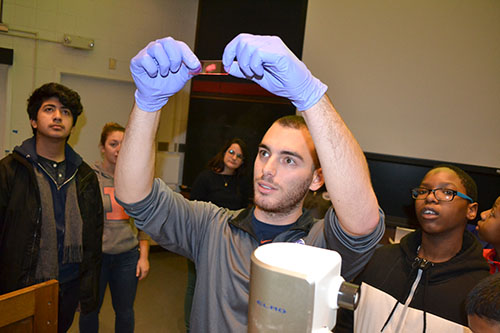
An AMS grad student shows a slide containing one of the materials they work with in their lab.
The December 7th campus visit exposed visitors to a number of STEM disciplines. For instance, researchers from the Sottos Group in the Beckman Institute’s Autonomous Materials Systems (AMS) group introduced youngsters to materials engineering with an interdisciplinary focus. According to Justine Paul, a second year PhD student in Material Science, AMS focuses on and gets a lot of inspiration from biology. “So how can we create synthetic materials that have similar properties and characteristics that we see in biology?” she asks. She indicates that AMS research works because different campus groups from a wide variety of different disciplines come together to collaborate on projects.
Cutting-edge research the group demonstrated to the visitors involved frontal polymerization, a manufacturing technique useful for vascular materials, 3D printing, or fiber-reinforced composites. Another area of research they addressed was transient polymers—polymers that can degrade on demand by shining a light on them.
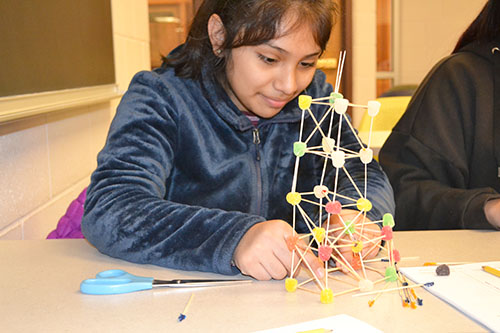
A ChiS&E seventh grader works on her team's toothpick-gumdrop structure.
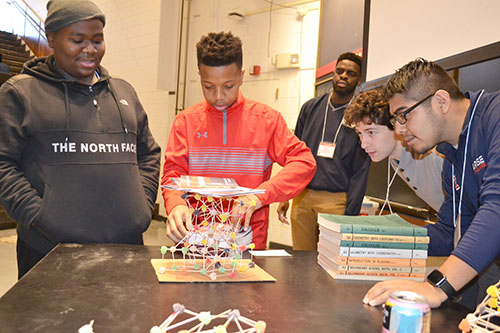
llinois engineering students (right) watch as two Chicago seventh graders test their structure by piling books on it.
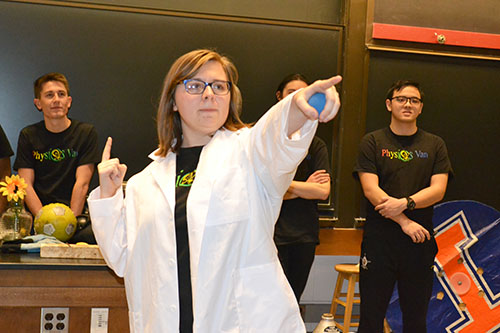
Physics Van coordinator Spencer Hulsey interacts with the Chicago students during one of her group's demos.
Following the AMS presentation, the entire group then broke into activities by grade. For instance, the seventh graders experienced civil engineering and physics while making toothpick-gumdrop structures. The idea was to design a structure that could withstand the weight as book after book was piled on their structure. Winners were decided via an algorithm based on the structure’s height and the number of books it held.
The eighth graders did a computer science/electrical engineering activity using Python code to program an LED Gemma board, with the goal of making it light up at different times in response to different inputs.
The pièce de résistance of the day was the Physics Van presentation. Its unique combination of slap stick comedy and physics both entertained and engaged the audience, all while exposing the visitors to key scientific principles.
Grainger Engineering’s outreach coordinator, Lara Hebert, who’s in charge of Illinois’ involvement in the umbrella ChiS&E program, cites the benefits for the Chicago students (and parents) of the campus visit. For one, they got exposed to the campus. Hebert claims the event “brings them to campus, and they get an opportunity to interact with a lot more faculty, and students, and research, and our buildings.” She adds that it helps the participants “really get to know the campus a little bit more closely than they do from us going up there.”
And it isn’t just the students who benefit from the campus visit. Another equally important emphasis of the day is both exposing the parents to STEM and giving them an opportunity to learn more about the campus. In fact, one session was for parents only, so they could ask questions.
Hebert emphasizes that getting families on campus is a key component to kids choosing STEM careers. “We love it that they come as a family, because the parents are given the opportunity to start thinking about if students are going to pursue STEM degrees or STEM careers, what they need to be thinking about in terms of course selection.”
Hebert adds that one key emphasis was fostering connections among all the stakeholders. “So we have a lot of opportunities for our university students to connect with the high school and middle school students, as well as our opportunity to connect as a campus with parents.”
Another benefit of the program is the long-term interactions that it encourages with the kids. For instance, the oldest kids in the program right now are in the 11th grade. According to Hebert, Illinois’ ChiS&E has been interacting with them off and on since they were in sixth grade. (While the umbrella program is currently working with grades 3–11, Illinois’ involvement in fall 2019 was with the seventh, eighth, and eleventh grades.) So with help from the Physics Department, ChiS&E volunteers have been doing a physics curriculum with the 11th graders—who weren’t on the campus visit because they were in Chicago doing a workshop with Engineering’s Technology Entrepreneur Center.
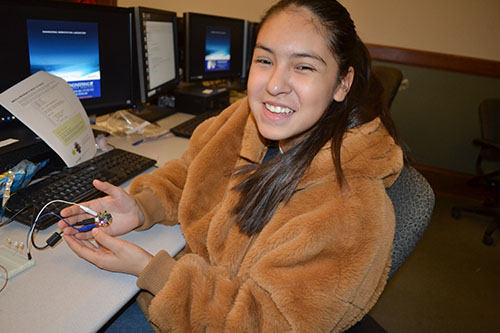
Whitney eighth grader Quiriat Ortiz shows off the circuit she made then programmed.

An Illinois engineering student (right) works with a Chicago eighth grader during the Computer Science activity.
Regarding its goal to recruit underserved students into engineering, the program appears to be achieving it. For instance, one Chicago student who’s been impacted through her long-term ChiS&E involvement is Quiriat Ortiz, an eighth grader from Eli Whitney School who got involved in third grade.
“Oh yeah, I've been doing it for a while,” she admits, and has continued to be involved because she likes science and engineering. In fact the program has impacted her career plans. “It's one of my goals to become an engineer,” she says. Regarding which discipline, she hasn’t made up her mind yet. She likes material and mechanical, adding, “I'm interested in computer science or material engineering. Her favorite thing about the day was the computer/electrical engineering activity. “Probably connecting the LCD and learning about the lights, making them go on and off.” Never having done coding like this before, Ortiz says the ChiS&E event was her first time.
Based on Ortiz’ comments, another side benefit of ChiS&E has been to familiarize the youngsters with the different engineering disciplines. Such is the case with another student interested in engineering—Dick Tracy, a seventh grader who’s been in ChiS&E since he was in third grade. His mom, April Dennis-Mac reports, she encouraged her son to get involved with the program because it was “Just something to see.” But once he took that first class, she says his interest in engineering “exploded! He's just been constantly saying, ‘I want to be an engineer. I want to be an engineer.’” She also likes that the program exposes him to the different engineering disciplines. “Right now, he's really stuck on mechanical engineering,” she asserts. “He's been there since probably about fifth grade, so he may have settled on it. But he does enjoy learning the different types of engineering.”
The Chicago students aren’t the only ones to benefit from the program—Illinois Engineering undergraduates reap rewards as well. For instance, Hebert says they take a van full up to Chicago each Saturday of the program—usually between 10 to 14 undergraduates make the trip in order to work with the younger students.
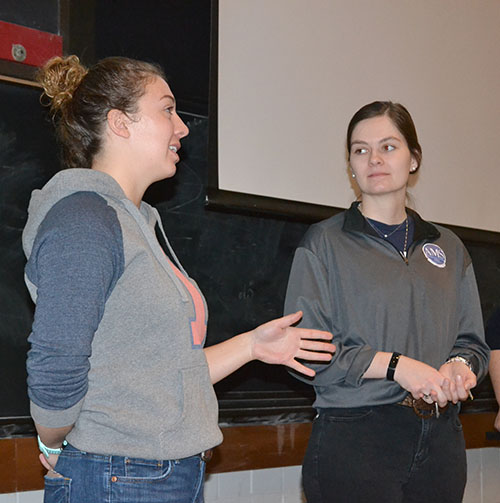
Justine Paul and Suzanne Peterson of AMS' Sottos Group explain their research to the ChiS&E visitors.
With so many engineering undergrad volunteers needed to keep the program running, the needed man (or woman) power has come from two sources. For example, Hebert teaches ENG 298: STEM Education Practicum. One of the course requirements is that students participate in the ChiS&E outreach in Chicago. (Another ChiS&E-related course Hebert also teaches in the spring semester, ENG398: Social Justice, also provides volunteers for the spring semester program.) Additional helpers come from the Worldwide Youth in Science and Engineering (WYSE) Leaders group, a pool of volunteers comprised of students who have already taken the course or gone through the training and have some experience under their belts.
However, it wasn’t just undergrads who participated in the outreach. Members of the AMS group, comprised of Ph.D. students and postdocs, as well s some undergrads,, share why they wanted to present during ChiS&E’s event. Justine Paul explains: “So I never really got some of these experiences when I was in middle school or elementary or high school. And I think it's great to be able to give back and share the experiences we have and to inspire and encourage these kids to pursue STEM and pursue their passions.”
She adds that she hopes to “provide any information about what we're currently doing that might not be on the news every day, but is something that is new and fascinating, and things that they might be working on later in their future.”

ChiS&E eighth graders use Python to program an LED Gemma board.
Agreeing with Paul, Suzanne Peterson, another PhD student, also believes it widens the kids’ horizons. “Cause we do some really cool things that, like Justine said, aren't in the news every day and that maybe some people don't really think about, like, ‘Oh, how are composites made?’ like, ‘Oh, well, that takes a lot of time and energy.’ We have this new method that optimizes those things and makes it a lot quicker and more environmentally friendly.”
A final unplanned benefit of the program appears to be clarification of one’s career choices. For instance, fifth-year Physics senior Will Helgren/Ochal, who claims he volunteered for the ChiS&E campus visit “mainly because I enjoy it!” shares an anecdote about how ChiS&E has impacted him.
It took Helgren/Ochal a while to figure out what he wanted to do that interested him in relation to science. He started in physics and thought he was going to go into theoretical academia. “But then, I volunteered for this program as a freshman, and I really fell in love with the idea of extracurricular education and teaching in general. And I've done it ever since really.” In fact, he loved it so much that Engineering eventually hired him to help organize and run the ChiS&E program. For example, he helped develop the circuitry lesson plan for this year’s batch of 11th graders.
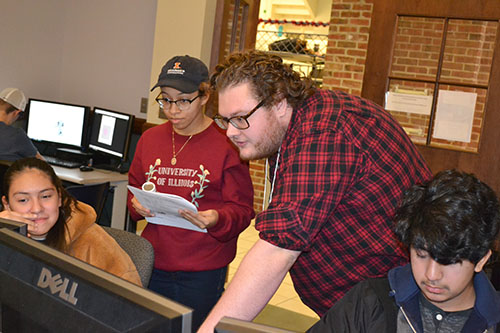
Will Helgren/Ochal (third from the left) works with an eighth grader during the Computer Science activity.
So, has his stint with ChiS&E changed his career plans? “Very much so,” he reports. Early on, he was planning to be a classroom professor just working theories on a blackboard the whole time. Then a negative experience with a specific class and one specific professor turned him off to that idea. However, it happens that at the exact same time, he was really getting into volunteering in extracurricular education. While it started out as, “Well, I'll just try this and see what happens,” he began to really enjoy “getting to do teaching and getting to help kids learn new topics that maybe they've been introduced to before,” but didn’t fully understand, and helping them to “grasp the idea in its completeness.”
He currently plans to apply to the College of Education for a Master's or a Ph.D, then get a teaching certificate in secondary, STEM, and/or special equity education. His dream job is to be either a high school teacher or work in extracurricular education outreach in a science museum.
Story and photographs by Elizabeth Innes, Communications Specialist, I-STEM Education Initiative.
Additional I-STEM web articles about ChiS&E:
More: 6-8 Outreach, Chicago Public Schools, ChiS&E, Underserved Minorities, 2020
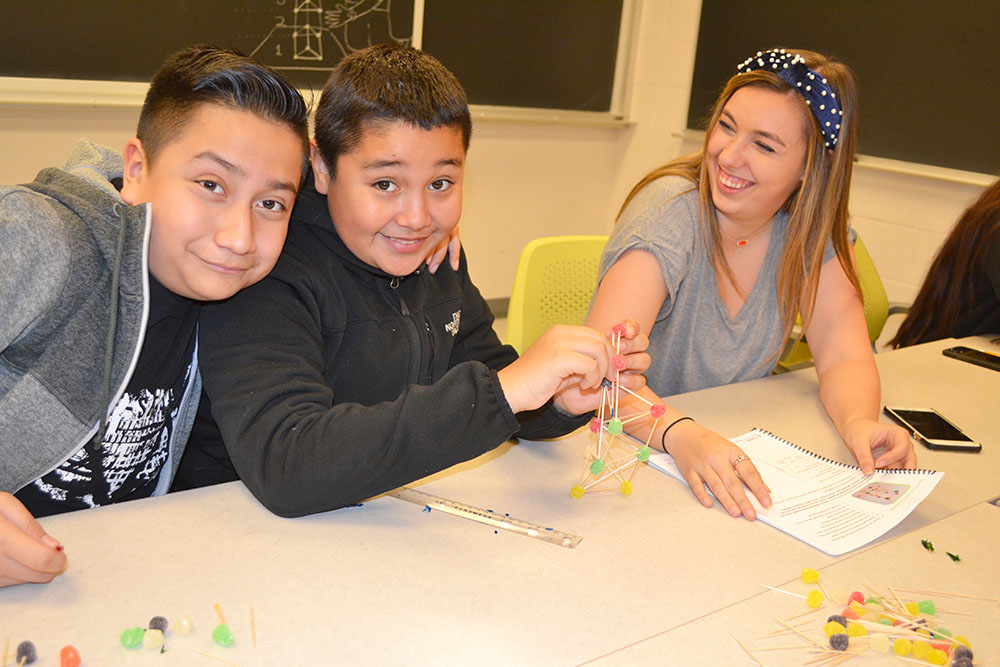
ChiS&E seventh graders work on a toothpick-gumdrop structure.













.jpg)
















